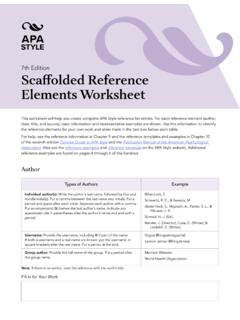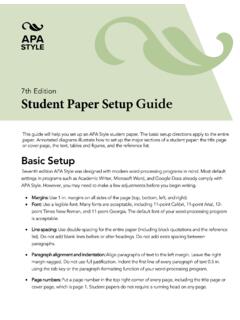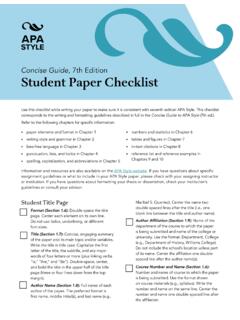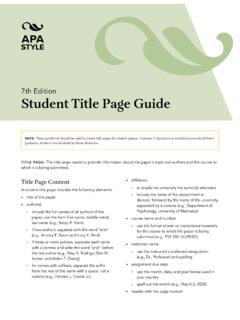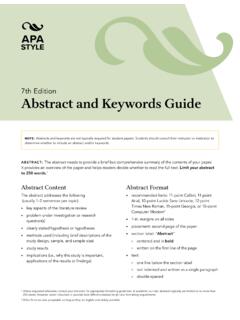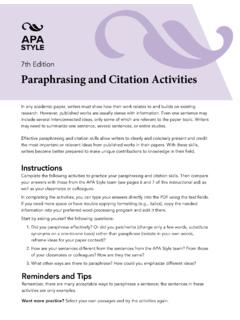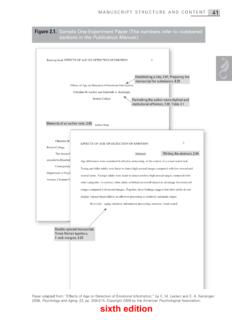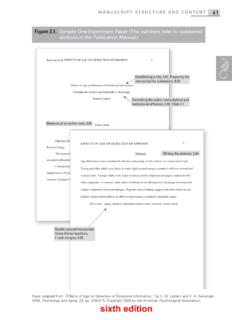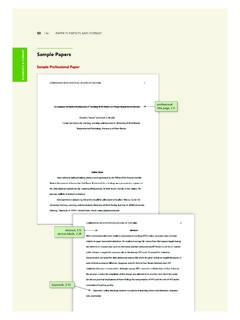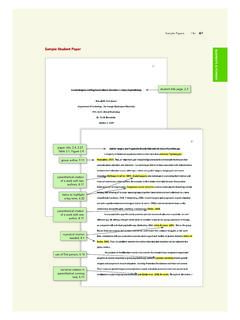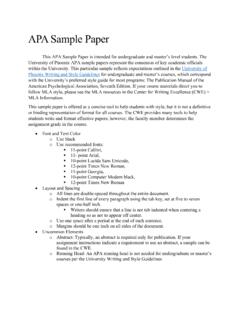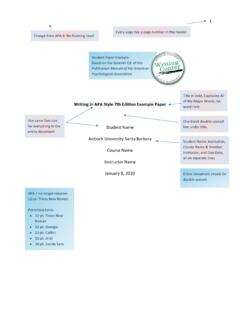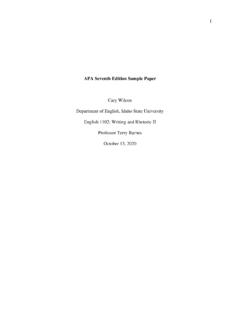Transcription of Publication Manual of the American ... - APA Style
1 INTRODUCTIONE xcellence in writing is critical for success in many academic and professional pursuits. APA Style is a set of guidelines for clear and precise scholarly com-munication that helps authors, both new and experienced, achieve excellence in writing. It is used by millions of people around the world in psychology and also in fields ranging from nursing to social work, communications to education, business to engineering, and other disciplines for the preparation of manuscripts for Publication as well as for writing student papers, dissertations, and theses. The Publication Manual of the American psychological association is the authoritative resource for APA Style , and we are proud to deliver its seventh Use APA Style ?
2 APA Style provides a foundation for effective scholarly communication because it helps authors present their ideas in a clear, concise, and organized manner. Uniformity and consistency enable readers to (a) focus on the ideas being pre-sented rather than formatting and (b) scan works quickly for key points, find-ings, and sources. Style guidelines encourage authors to fully disclose essential information and allow readers to dispense with minor distractions, such as inconsistencies or omissions in punctuation, capitalization, reference citations, and presentation of statistics. When Style works best, ideas flow logically, sources are credited appro-priately, and papers are organized predictably and consistently.
3 People are described using language that affirms their worth and dignity. Authors plan for ethical compliance and report critical details of their research protocol to allow readers to evaluate findings and other researchers to potentially replicate the studies. Tables and figures present data in an engaging, consistent you use APA Style for a single class or throughout your career, we encourage you to recognize the benefits of a conscientious approach to writing. Although the guidelines span many areas and take time and practice to learn, we hope that they provide a balance of directiveness and flexibility and will eventually become second nature.
4 177/23/19 4:37 PMCopyright 2020 by the American psychological Associationxviii INTRODUCTIONAPA Style for StudentsThe Publication Manual has long been an authoritative source for scholarly writ-ing, and this edition provides more targeted guidance and support for students. All students, no matter what career they pursue, can benefit from mastering scholarly writing as a way to develop their critical thinking skills and hone the precision and clarity of their communication. Most guidelines in the Publication Manual can be applied to both student papers and professional manuscripts. The Manual also has elements specifi-cally designed for students, including a student title page; guidance on citing classroom or intranet sources; and descriptions of common types of student papers such as annotated bibliographies, response papers, and dissertations and theses.
5 Journal article reporting standards (JARS) are intended primarily for authors seeking Publication but may be helpful for students completing advanced research and AccessibilityWe have created the seventh edition of the Publication Manual with the practical needs of users in mind. Within chapters, content is organized using numbered sections to help users quickly locate answers to their questions. This ease of navigability and depth of content mean that the Manual can be used as both a reference work and a textbook on scholarly edition promotes accessibility for everyone, including users with dis-abilities.
6 In consultation with accessibility experts, we ensured that the guide-lines support users who read and write works in APA Style through a variety of modalities, including screen readers and other assistive technologies. For exam-ple, we present a streamlined format for in-text citations intended to reduce the burden of both writing and reading them. We provide guidance on how to use adequate contrast in figures to meet Web Content Accessibility Guidelines (Web Accessibility Initiative, 2018). We also support the use of a variety of fonts and default settings in common word-processing programs, meaning that users need to make fewer adjustments to their systems to be ready to write in APA Style .
7 Above all, our aim is to support the many ways in which people commu-nicate. We encourage authors to be conscientious and respectful toward both the people about whom they are writing and the readers who will benefit from their work. What s New in the seventh edition ?Brief descriptions of new and updated content are provided next on a chapter- by-chapter basis. For a more comprehensive overview of content changes, see the APA Style website ( ).Chapter 1: Scholarly Writing and Publishing PrinciplesChapter 1 addresses types of papers and ethical compliance. New guidance addresses quantitative, qualitative, and mixed methods arti-cles as well as student papers, dissertations, and theses.
8 187/23/19 4:37 PMCopyright 2020 by the American psychological association INTRODUCTION xix Information on planning for and ensuring ethical compliance reflects best practices. Guidance on data sharing, including in qualitative research, reflects open practice 2: Paper Elements and FormatChapter 2 is designed to help novice users of APA Style select, format, and orga-nize paper elements. The title page is updated for professionals, and a new student title page is provided. For all papers, the byline and affiliation format on the title page aligns with publishing standards. The author note includes more information, such as ORCID iDs, disclosure of conflicts of interest or lack thereof, and study registration information.
9 The running head format has been simplified for professional authors and is not required for students. Font specifications are more flexible to address the need for accessibility. An updated heading format for Levels 3, 4, and 5 improves readability and assists authors who use the heading- styles feature of their word-processing program. Two new sample papers are provided: a professional paper and a student paper, with labels to show how specific elements appear when 3: Journal Article Reporting StandardsChapter 3 orients users to journal article reporting standards (JARS) and includes tables outlining standards for reporting quantitative, qualitative, and mixed methods research.
10 JARS for quantitative research has been significantly expanded and updated (see Appelbaum et al., 2018; Cooper, 2018). The updated JARS now cover qualitative and mixed methods research (see Levitt, 2019; Levitt et al., 2018). Chapter 4: Writing Style and GrammarChapter 4 provides guidance on writing Style and grammar. The singular they is endorsed, consistent with inclusive usage. More detailed guidance helps writers avoid anthropomorphism. Chapter 5: Bias-Free Language GuidelinesChapter 5 presents bias-free language guidelines to encourage authors to write about people with inclusivity and respect. Existing guidance on age, disability, gender, racial and ethnic identity, and sexual orientation has been updated to reflect best practices.
